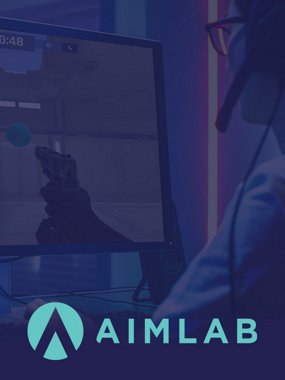Aim Lab

There have been several big breakthroughs in the computer games industry. But one of the biggest happened in 1999, when a couple of American amateur developers reassembled the Half-Life engine and based it on the tactical team shooter Counter-Strike. The game instantly became popular as it offered a unique multiplayer gameplay in which you had to coordinate with the rest of the party.
Since then, tactical shooters have become one of the most popular genres of computer games. And then they turned into a full-fledged e-sports discipline - with world championships, their own "stars" and millions of fans. And the developers began to release tactical shooters, several pieces a year.
And each developer hoped that his product would become the most popular, demanded and included in the list of eSports disciplines. Therefore, in tactical shooters, the balance is now being verified, the gameplay is being worked out and the gameplay mechanics are being carefully thought out - so that players win thanks to their skills, and not because of the purchase of some particularly powerful gun.
The problem is that skills need to be taken from somewhere. And there are two options. The first is the path of trial and error, with dozens of lost matches, with the bitterness of defeat and the need to "get up after a fall." The second is to use the Aim Lab training simulator.
Who is holding a gun like that? He will fly out of the hands after recoil!
Aim Lab is a virtual shooting range designed to teach the player how to properly handle weapons in first or third person shooters. The key feature of the project is that the developers use machine learning.
This soulless robot trainer monitors player behavior in the virtual shooting range and gives advice on how to use weapons. How to aim, how to hold, how to move, how to reload, and so on. First, the player is asked to shoot several colored targets, and then Aim Lab looks at exactly how the gamer was holding a virtual pistol in his hands, identifies weaknesses and gives detailed recommendations on how to fix them.
The project is able to adapt to the needs of the gamer, depending on the game. So, Fortnite training will be slightly different from shooting in PUBG or Overwatch. This allows you to achieve maximum results not only in shooters in general, but also in any one specific game in particular.
The list of compatible and suitable games for training is impressive - even though Aim Lab itself has been in early access and pre-alpha versions for quite some time. In mid-2020, the developers announced that the virtual shooting range was only 40% complete. However, the list of compatible games includes almost all modern and popular shooters (as well as survivals and battle royals) - from Destiny 2 to Overwatch, from Fortnite to PUBG, from Call of Duty: Black Ops 4 to CS: GO. Even Minecraft is in the list of projects.
Assortment of virtual weapons in the Aim Lab
What the Aim Lab additionally boasts is the number of virtual weapons. It is understandable why the developers are working so slowly on their brainchild - there are several hundred (!) Guns, each with unique behavior and features.
There are pistols, shotguns, and sniper rifles. More exotic weapons are also presented - rocket launchers, throwing knives, even fireballs. Hitscan guns (which check the hit rate before firing) migrated from Overwatch. In general, you can practice using almost any of the existing types of weapons.
And all this is also customizable. You can customize the parameters of weapons, sight, target colors, virtual shooting range map and much more. The developers are also planning to add integration with Steam Workshop so that users from all over the world can share the created "guns", locations and gameplay mechanics.
Aim Lab Statistics and Parameters
The Aim Lab virtual shooting range monitors six main parameters of player behavior - and makes recommendations for each:
- Stability. The more small movements the player makes, knocking down the sight, the lower this parameter;
- Tracking. The better the player follows the target, "leads" it and holds it in the crosshairs of the weapon, the higher this parameter;
- Speed. The faster the player switches between targets, reloads weapons and makes decisions on the battlefield, the higher this parameter;
- Accuracy. The fewer shots the player makes "milk", the higher this parameter;
- Perception. The sooner the player selects the desired target and more sensitively reacts to changes in the battlefield, the higher this parameter;
- Cognitive functions. This parameter characterizes how, in principle, the player's thinking is "sharpened" for shooters.
Don't get upset about low values - the game will help you raise each one.


















